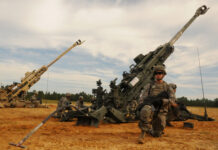While rocket artillery has been around for a very long time, recent decades have seen improvements to accuracy and firepower, coupled with extensive proliferation. This has resulted in the present situation, where multiple rocket launchers (MRLs) are a common and often highly oppressive presence on the modern battlefield, with significant second-order effects beyond their immediate lethality.
Past, Present and Future
The first generation of Soviet MRL systems, the BM-8, BM-13 and BM-31-12 Katyushas and the second generation BM-14 and BM-24 systems were capable, but they shared a number of limiting features. Combat ranges were not as long as required, thereby increasing system vulnerability to counter-battery fire, rockets still suffered from dispersion making accurate engagements difficult. To an extent it was possible to compensate for dispersion by increasing the warhead size to maximise the effects on target, although this would exact a penalty in range. The other option was to mass MRL systems and simply saturate the target area with rockets, thus overcoming the dispersion issue by having a statistically high probability of hitting the target.
To overcome the accuracy limitations of the time, the Soviet military tasked what is today the Splav State Production and Research Enterprise (NPO Splav) with finding a solution. Splav was essentially the centre of excellence for Soviet MRL design and production, being established at Tula in 1945. Currently part of the Rostec organisation, Splav remains the centre of Russian MRL industrial activity.
By the early 1960s, Splav had started work on a new MRL system that would feature a newly designed 122 mm calibre rocket. By 1963 the new system had entered service with the Soviet Army as the BM-21 Grad. The BM-21 supposedly first saw combat service in March 1969 during border fighting between the Soviet Union and China. Today the BM-21 remains the most widely used MRL system globally. It has also provided the basis for numerous indigenous MRL programmes around the world. The BM-21 continues to be a highly regarded combat asset, and some 60 years after its debut with the Soviet Army, the BM-21 remains in near-constant combat use by Russian and Ukraine ground forces in the current conflict in Ukraine.

Credit: Ukraine Joint Forces Command
Ukraine also has a derivative version of the BM-21 system in service, known as the RM-70, originally developed to meet the requirements of the then Czechoslovak Army. The system is mounted on a Tatra 813 6×6 truck, there is 40-tube launcher as well as a 40-rocket reload pack mounted on the vehicle for rapid reloading. Initially the system used standard Soviet 9M22 rockets, which possessed a high explosive fragmentation (HE-FRAG) warhead, and had a range of 20.38 km, and 9M28 rockets with an HE-FRAG warhead and a 15 km range. Later there were locally developed 122 mm rockets, such as the JROF and JROF-K, both HE-FRAG natures, with a range of 20.75 km and 11 km respectively. Other natures included: Tmovnik with anti-armour bomblets, Kuš with PPMi-S1 anti-personnel minelets and the Krizhna-R with four PTMi-D anti-tank mines. Additionally, RM-70 can also launch all standard Soviet/Russian 122 mm rockets.
The Czech Republic supplied Ukraine with more than 20 RM-70 systems in April 2022 and in July 2022 supplied a number of RM-70 Vampire systems. These latter systems are mounted on a Tara T815 chassis, and feature various improvements, including a modern fire control system, but still keep the 40 launch tubes plus the 40-round reload pack configuration. The Czech Republic in mid-2022 also purchased an unknown number of BM-21 systems from Bulgaria that were then supplied to Ukraine. Poland also supplied Ukraine with over 20 BM-21 systems in April 2022. It is also fair to assume that Ukraine now has access to substantial 122 mm rocket stocks from its own resources, but also from within NATO Europe and elsewhere, if required.

Credit: Czech Army
Returning to the BM-21, when it first entered service it was a massive upgrade in terms of MRL performance. According to Soviet military writings from the early 1980s, the BM-21 had four times the salvo weight of the original BM-13 Katyusha and eight times the destructive capability! Bearing in mind that since that point, 122 mm rockets have been developed that feature increased range and enhanced payloads, increasing the destructive capability of the system even further.
The original BM-21 system consisted of a 40-tube launcher mounted on a Ural-375D truck, various other system configurations were also developed/proposed, but the original variant is the one most likely to be encountered. As regards ammunition, there is a diverse collection of 122 mm rockets available, both Soviet era and types more recently developed in Russia. Apart from the standard HE-FRAG natures, there are smoke, incendiary, illumination and chemical types, as well as rocket natures with different submunition payloads, including anti-tank and anti-personnel systems, there was even an RF jammer rocket payload.

Credit: Ukraine Ground Forces
In 2014 the Russian Army introduced a new evolution of the BM-21 into service in the form of the 9K51M Tornado-G system. This was a substantial upgrade, introducing the 2B17-1 launch vehicle mounted on a Ural truck chassis. The vehicle was equipped with an automated fire control system (FCS), coupled with GLONASS navigation system. This enables the crew to conduct fire missions more rapidly, since they can aim to a grid reference point and the FCS will automatically lay the launcher onto the target coordinates.
Alternatively, a battery of these vehicles can be cued to automatically engage target coordinates designated by Kapustnik-BM artillery command and fire control vehicles. The Tornado-G is also armed with a range of extended-range 122 mm rockets including the 9M521, with a 40 km maximum range, and the 9M522, with a 37.5 km maximum range, as well as various other rocket natures.
Ukraine has also sought to modernise its BM-21 fleet, with various upgrade proposals focussed on replacing the truck chassis of the system, with a Ukrainian-manufactured KrAZ chassis. Upgrades have included the Bastion-01 and Bastion-02 systems, the Verba system and the BM-21UM Berest. The latter is mounted on a KrAZ 536 4×4 chassis and features a 50-round launcher. Ukraine Ground Forces would have significantly upgraded their MRL capabilities prior to the current conflict if they were able to, but the money was not available. As such, limited numbers of upgraded systems have been fielded, but not in the quantities required.
There is often speculation that Belarus might be drawn into the conflict between Russia and Ukraine, if that unfortunate development does occur, this will see another BM-21 user enter the fray. Belarus also has its own upgraded version of the BM-21 in service, this has the BM-21A designation and is mounted on a new truck chassis, with a standard 40-round launcher and a 40-round reload pack on the vehicle.
As previously mentioned, the BM-21 is in service all over the world and this means that there are numerous manufacturers of 122 mm rockets globally. China. Egypt, Iran, North Korea and Pakistan all produce 122 mm rockets, and it should be noted that both Iranian and Pakistani tube artillery ammunition has been supplied to Ukraine since the conflict started. However, it seems likely that for Ukraine, Poland represents the best source for both standard and extended-range 122 mm rocket natures. Of particular interest will be their 42 km HE-FRAG nature and a 32 km range rocket with various different submunition payloads.
Hurricanes and More
The fact that both Russia and Ukraine operate so many of the same MRL systems and have an artillery and MRL employment doctrine based on the same historical experiences, creates a very unique situation. Such awareness of the military doctrine of an opponent and the culture associated with the formation of doctrine is extremely rare. With Ukraine receiving advanced weapons from the US and other NATO nations, it is now in a position to develop its own doctrine and base it on operational experience gained since 2014, and more specifically in the current phase of the conflict since February 2022.
The BM-27 Uragan is another MRL system in service with both Russia and Ukraine, work on this system began in the 1970s as the then Soviet Army looked to field an MRL capability that could deal with a changing and more complex target array. To that end they were looking for an MRL system that had greater range than existing types, was more accurate and had greater on target effects. This led them to basing the system on a larger-calibre 220 mm rocket that had a greater payload/warhead and could offer the desired increased range. Operationally, the idea was to have a system that could accurately strike targets in the depth of the enemy position and neutralise them.

Credit: Ukraine Ground Forces
The BM-27 system is based on an 8×8 ZIL-135 truck chassis, it has 16 launch tubes and maximum range of the 220 mm rockets is 35 km. Rocket natures include HE-FRAG, bomblet, anti-tank and anti-personnel munitions and anti-tank mines. The Uragan-1M is the latest Russian BM-27 variant to be introduced into service, this is based on a new truck platform and is reportedly equipped with extended-range rockets with a maximum range of around 70 km. Ukraine has introduced its own developed version of the BM-27 in the form of the Bureviy, this is mounted on an 8×8 Tatra T815-7T3RC1 chassis, equipped with a digital fire control system, 16 launch tubes and access to an extended range rocket capable of engaging targets out to approximately 65 km.
Also in service with both Russia and Ukraine is the BM-30 Smerch system, this came into service at the end of the 1980s and continued the Soviet MRL design trends of that era, delivering more range, accuracy, payload and destructive effect. The Smerch system is based on the 8×8 MAZ-543 chassis, the system has 12 launch tubes and initially its 300 mm rockets had a range of around 70 km, rocket natures available include HE-F and submunition. Ukraine has developed an evolution of the Smerch system known as the Vilkha, the standard rocket has a range of 70 km, an extended-range rocket with a range of some 130 km has been fielded and other rockets are being developed. The successor to the Smerch system in Russian service is the 9K515 Tornado-S. The launch vehicle is based on the MZKT-79306 8×8 truck chassis, the launcher is derived from the Smerch system and it uses the standard 300 mm rocket natures, as well as the 9M542 rocket with a range of 120 km and the guided 9M544 and 9M549 rockets, also reportedly possessing a range of 120 km. Like the Tornado-G, the Tornado-S has also been upgraded with a GLONASS navigation system and an automated FCS, to enable automatic cueing and laying launchers onto the target coordinates.
Mention should also be made of the Russian TOS-1/TOS-1A systems, these are based on a T-72 tank chassis, and mount a 220 mm rocket launcher with either 30 (TOS-1) or 24 (TOS-1A) tubes. Rocket natures are thermobaric, with the system being used for relatively short-range engagements against fortified positions or in urban environments.
Eastern Problems and Western Solutions?
The development of Soviet and post-Soviet MRL capabilities was obviously slowed by the collapse of the Soviet Union and the economic chaos and industrial decline that plagued the post-Soviet successor states. Recovering from years of systematic underinvestment in the military and the defence industry has not been easy. Even Russia, which has been in a better position than most in the post-Soviet space to invest in defence, took a considerable time to reinvigorate its military and defence industry. The performance of Russian forces and equipment since the February 2022 invasion of Ukraine would seem to indicate that the Russian investment in defence has not had the transformational effects that the Russian leadership apparently expected.
Artillery has always been seen as a strength of the Soviet Army and its Russian successor, but combat performance in Ukraine appears to demonstrate that all is not well in terms of tube and rocket artillery. A technology gap appears to have opened up between Russia and the West, particularly in terms of the broader defence electronics sector. Russia had been moving towards developing and fielding its ideal MRL solution, it could meet the range requirement and could produce the warhead/payload required, what it could not do was meet its accuracy requirements for extended range engagements, due to the fact it was not able to build guided rocket artillery munitions in quantities useful to conducting a major war. This has resulted in Russia primarily relying on unguided ‘dumb’ munitions for the overwhelming majority of its fire missions. Added to this, weaknesses have been exposed in Russian reconnaissance, surveillance and targeting capabilities, further diluting artillery performance.
Considering how long Russia has been working on MRL systems and the immense operational experience that it has with such systems, it must be very frustrating for them to see Ukraine using HIMARS and MLRS systems to such great effect. These systems are achieving the precision targeting that Russia has been working towards for so many years and has failed achieve at relevant scale. Furthermore, these US systems have a growth path in place to keep them in service for many years to come, introducing longer-range and even more accurate rockets.

Credit: Ukraine Joint Forces Command
Events in Ukraine since the Russian invasion have demonstrated that MRL systems can still neutralise area targets as successfully as they have always done. The key development in the artillery rocket sector from combat operations in Ukraine is that the MRL can now also deliver a long-range precision strike capability, allowing for the engagement of high value targets in the strategic depth of the opposing force. While accuracy in rocket artillery is generally desirable, this quality has taken on heightened importance in the present war, given that air defences on both sides of the conflict have hindered the carrying out of strikes from the air. As such, it has fallen on rocket artillery to carry out some of the tasks which in other wars might have been conducted by aircraft. This has resulted in increased pressure on MRL accuracy and availability.
David Saw











